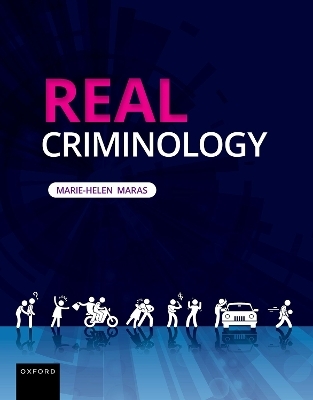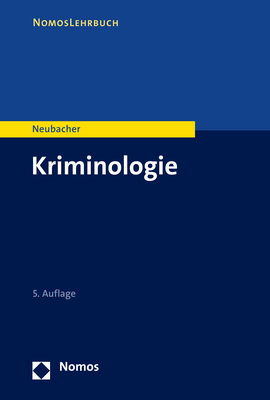
Real Criminology
Oxford University Press Inc (Verlag)
978-0-19-090402-9 (ISBN)
This comprehensive resource for the Introduction to Criminology course shows students how to think logically and critically about real, contemporary cases and issues in criminology, engaging each student in a dynamic process of discovery.
Real Criminology draws on the latest literature from a range of fields to analyze and explain crime. Through this interdisciplinary lens, the textbook introduces students to criminology; types of crime; impacts of crime; theories explaining crime, criminality, and victimization; studies on crime, offenders, victims, and witnesses of crime; and the nature and extent of crime in the United States and abroad.
Available as an enhanced eBook, each section is a self-contained unit of pedagogy integrating text, media, and assessment, all corresponding to learning objectives. The text incorporates not only videos and assessments but references to popular films, TV shows, fiction books, music, and games, as well as discussions of well-known national and international crimes, drawing readers' attention to how crimes and criminal behavior are depicted in the media.
Marie-Helen Maras is an Associate Professor at John Jay College of Criminal Justice.
Part 1: THE NATURE AND EXTENT OF CRIME
Chapter 1: Crime and Criminology
1.1: Crime, Law, and Justice
1.1.1:. Classifications of Crime
1.1.2: The Evolution of Crime
1.1.3: Criminal Justice
1.2: Criminology
1.2.1: What Do Criminologists Do?
1.2.2: Theories of Crime
1.2.3: Cybercriminology
1.3: Critiques and Implications of Crime, Law, Justice, and Criminology
Case Study: Don't F**k With Cats
Check Your Understanding
Key Terms
Definitions
Endnotes
Chapter 2: Measuring Crime
2.1: Reporting and Measuring Crime
2.1.1: Uniform Crime Reporting Program
2.1.2: National Incident Based Reporting System
2.1.3: National Crime Victimization Survey
2.1.4: Self-Report Surveys
2.1.5: International Crime Measurement Tools
2.2: The Dark Figure of Crime
2.3: Cybercrime Measurement
2.4: Critiques and Implications of Crime Measurement Tools
Case Study: Evaluating Crime Measurement Tools
Check Your Understanding
Key Terms
Chapter 3: Victims and Victimization
3.1: The Impacts of Victimization
3.1.1: Direct Costs
3.1.2: Indirect Costs
3.2: Victims' Attributes
3.2.1: Demographics
3.2.2: Victim-Offender Relationship and Race/Ethnicity
3.2.3: Repeat Victimization
3.3: Victimization Theories
3.3.1: Victim Precipitation Theory
3.3.2: Lifestyle Exposure Theory
3.3.3: Routine Activity Theory
3.3.4: Critiques and Implications of Victimization Theories
3.4: Victim Blaming and Secondary Victimization
3.4.1: Explanations of Victim-Blaming Behavior
3.4.2: Rape Myths
3.4.3: Secondary Victimization
3.5: Victims' Rights
3.5.1: Campaigns for Women's Rights
3.5.2: The Crime Victims' Rights Act
3.5.3: Victim Services
3.5.4: Victim Impact Statements
Case Study: Applying Victimization Theory to Child Sexual Assault
Check Your Understanding
Key Terms
Definitions
Endnotes
Part 2: CRIME CAUSATION AND REDUCTION
Chapter 4: Rational Choice Theory
4.1: The Idea of Crime as a Rational Choice
4.1.1: The Classical School of Criminology
4.1.2: Components of Rational Choice Theory
4.2: Responding to Crime
4.2.1: Retribution
4.2.2: Deterrence
4.2.3: Incapacitation
4.2.4: Rehabilitation
4.3: Reducing Crime
4.3.1: International Cooperation
4.3.2: Situational Crime Prevention
4.3.3: Displacement
4.3.4: Commodification of Security
4.4: Critiques and Implications of Theories
Case Study: Applying Rational Choice Theory to Terrorism
Check Your Understanding
Key Terms
Definitions
Endnotes
Chapter 5: Trait Theories: Biological and Psychological Predisposition
5.1: The Positivist School and Trait Theories
5.2: Biological Trait Theories: Criminals Are Born, Not Made
5.2.1: Physiological Characteristics
5.2.2: Evolution
5.2.3: Biochemical Influences
5.2.4: Neurological Influences
5.3: Psychological Theories: The New Positivists
5.3.1: Intelligence
5.3.2: Mental Disorders
5.3.3: Personality Theories
5.3.4: Emotions
5.3.5: Psychoanalytical Theories
5.3.6: Attachment Theory
5.4: Critiques and Implications of Theories
Case Study: Applying Trait Theories to Mass Murder
Check Your Understanding
Key Terms
Definitions
Endnotes
Chapter 6: Social Structure Theories: Crime, Culture and Inequality
6.1: Social Structure Theories
6.1.1: Chicago School of Criminology
Human Ecology and Concentric Zones
Social Disorganization Theory
Hot Spots, Crime Mapping, and Deviant Places
Social Capital and Collective Efficacy
Broken Windows Theory
6.2: Strain Theories
6.2.1: Anomie: Concept and Theory
6.2.2: Relative Deprivation Theory
6.2.3: Institutional Anomie Theory
6.2.4: General Strain Theory
Sources and Management of Strain
6.3: Cultural Deviance Theories
6.3.1: Theory of Delinquent Subcultures
6.3.2: Theory of Differential Opportunity
6.4: Critiques and Implications of Theories
Case Study: Applying Social Structure Theory to Fraud
Check Your Understanding
Key Terms
Definitions
Endnotes
Chapter 7: Social Process Theories: Conformity, Learning, and Sources of Social Control
7.1: Controlling Criminality
7.2: Learning Criminality
7.3: Neutralizing Offenses
7.4: Moral Disengagement
7.5: Developmental and Life Course Criminology
7.5.1: Latent Trait Perspective
Control Balance Theory
General Theory of Crime
7.5.2: Life Course Perspective
7.6: Critiques and Implications of Theories
Case Study: Applying Social Process Theories to Involuntary Manslaughter
Check Your Understanding
Key Terms
Definitions
Endnotes
Chapter 8: Labeling and Moral Panics: Constructing and Reacting to Crime
8.1: The Label of Deviant or Criminal
8.1.1: Crime as Theater
8.1.2: Crime Through the Lens of Social Psychology
8.1.3: Implications of the Deviant or Criminal Label
8.2: Shaming and Sanctions
8.2.1: Reintegrative and Disintegrative Shaming
8.2.2: Public Shaming
8.2.3: Online Shaming and Trial by Internet
8.2.4: Shaming Sanctions
8.2.5: Defiance Theory
8.3: Moral Panics and Social Contagion
8.3.1: Moral Panics
8.3.2: Social Contagion
8.3.3: Theories and Perspectives on Moral Panics
8.4: Critiques and Implications of Theories
Case Study: Applying Moral Panics to Comic Books
Check Your Understanding
Key Terms
Definitions
Endnotes
Chapter 9: Conflict Criminology: Effects of Class, Power, Gender, and Race
9.1: Introducing Conflict Theories
9.2: Types of Conflict Criminology
9.2.1: Radical Criminology
9.2.2: Left Realism
9.2.3: Peacemaking Criminology
9.2.4: Feminist Criminology
Women and Criminological Theory
Gendered Perspectives on Crime
9.2.5: Race and Crime
9.3: Critiques and Implications
Case Study: Applying Conflict Criminology to the Criminal Justice System's Responses to Racial Minorities
Check Your Understanding
Key Terms
Definitions
Endnotes
Part 3: CRIME TYPOLOGIES
Chapter 10: Antisocial Behavior and Interpersonal Crime
10.1: Criminal Antisocial Behavior
10.1.1: Trolling
10.1.2: Bullying
10.1.3: Harassment
10.1.4: Stalking
10.2: Family and Intimate Partner Violence
10.2.1: Domestic Violence
10.2.2: Marital and Intimate Partner Rape
10.2.3: Murder
10.2.4: Child Maltreatment
10.2.5: Elder Abuse
10.2.6: Honor Killings
10.3: Community Violence
10.3.1: Assault
10.3.2: Robbery
10.3.3: Sexual Abuse
10.3.4: Mass, Spree, and Serial Murder
10.3.5: Hate Crime
10.3.6: Active Shooting
Workplace Violence
School Shooting
10.4: Controlling Antisocial Behavior and Interpersonal Crime
Challenging Your Assumptions
Case Study: Controlling Active Shooter Incidents
Check Your Understanding
Key Terms
Endnotes
Chapter 11: Property Crime and White-Collar Crime
11.1: Property Crime
11.1.1: Larceny-Theft
11.1.2: Trespass
11.1.3: Vandalism
11.1.4: Burglary
11.1.5: Shoplifting
11.1.6: Motor Vehicle Theft
11.1.7: Arson
11.1.8: Identity Theft
11.1.9: Intellectual Property Theft
11.1.10: Fraud
Bank Fraud
Phishing
Advance Fee Fraud
Catfishing
11.1.11: Extortion
11.2: White-Collar Crime
11.2.1: Bribery and Public Corruption
11.2.2: Securities Fraud
11.2.3: Insider Trading
11.2.4: Bankruptcy Fraud
11.2.5: Insurance Fraud
11.2.6: Healthcare Fraud
11.3: Controlling Property Crime and White-Collar Crime
Case Study: Applying Techniques to Prevent White-Collar Crime
Check Your Understanding
Key Terms
Definitions
Endnotes
Chapter 12: Deviant Acts and Public Order Crimes: Paraphilia, Sex Work, Drug Use, and Gambling
12.1: The Relationship Between Law and Morality
12.2: Deviance
12.3: Public Order Crimes
12.3.1: Sex Work
The Impacts Associated with the Sex Work
Sex Work and the Law
12.3.2: Drug Use and Crime
Substance Abuse
Prescription Drugs and the Law
12.3.3: Gambling
Addiction
Gambling and the Law
Sports Betting
Internet Gambling
12.4: Controlling Deviance and Public Order Crimes
Case Study: Sugaring
Check Your Understanding
Key Terms
Endnotes
Chapter 13: Transnational Organized Crime
13.3: Organized Crime
13.3.1: Group Structure
13.3.2: Criminal Activities
Money Laundering
Cybercrime
3.4: Trafficking in Persons
13.2.1: Sex Trafficking
13.2.2: Labor Trafficking
13.2.3: Organ Trafficking
13.3: Human Smuggling
13.4: Drugs Trafficking
13.5: Firearms Trafficking
13.6: Cigarette Trafficking
13.7: Precious Metals and Gemstones Trafficking
13.8: Cultural Property Trafficking
13.9: Environmental Crime
13.9.1: Wildlife Crime
13.9.2: Pollution Crime
13.10: Controlling Transnational Organized Crime and Cybercrime
Case Study: Controlling Wildlife Crime
Check Your Understanding
Key Terms
Definitions
Endnotes
| Erscheinungsdatum | 20.03.2023 |
|---|---|
| Verlagsort | New York |
| Sprache | englisch |
| Maße | 211 x 267 mm |
| Gewicht | 953 g |
| Themenwelt | Recht / Steuern ► EU / Internationales Recht |
| Recht / Steuern ► Strafrecht ► Kriminologie | |
| Recht / Steuern ► Strafrecht ► Strafverfahrensrecht | |
| Sozialwissenschaften ► Pädagogik | |
| Sozialwissenschaften ► Soziologie | |
| ISBN-10 | 0-19-090402-X / 019090402X |
| ISBN-13 | 978-0-19-090402-9 / 9780190904029 |
| Zustand | Neuware |
| Informationen gemäß Produktsicherheitsverordnung (GPSR) | |
| Haben Sie eine Frage zum Produkt? |
aus dem Bereich


